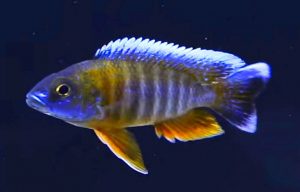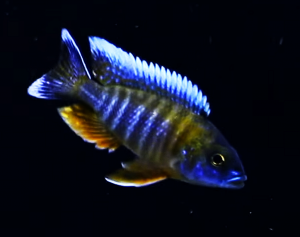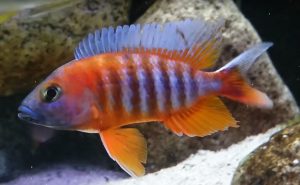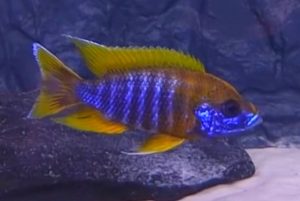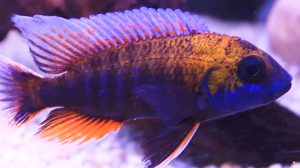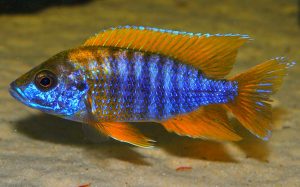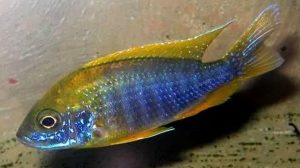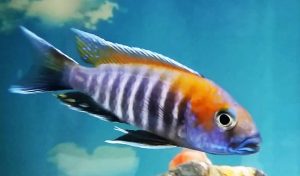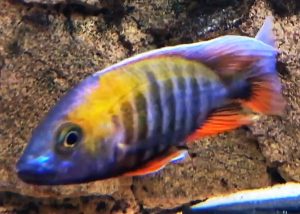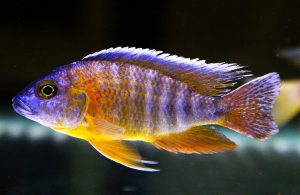The African Butterfly Peacock Cichlid (Aulonocara jacobfreibergi) known to tropical fish keeping enthusiasts as Malawi Butterfly Cichlid, Eureka Cichlid, Fairy Cichlid, Freiberg’s Peacock, Jakes or Jake Cichlid, Mamalela Peacock, and Swalllow Tail Peacock is endemic to Lake Malawi, Africa; Otter Point, Nkudzi, Monkey Bay, Nankumba, and the Domwe Islands.
Aulonocara jacobfreibergi is widespread throughout the southern part of Lake Malawi and is listed as Least Concern on the IUCN Red List of endangered species.
Of the 23 Aulonocara species, the African Butterfly Peacock (Aulonocara jacobfreibergi) is one of the most colorful and most variable in color and size. Natural color strains and sizes vary between individual populations from 4″ to over 9″ in length.
There are many variants of Aulonocara available to tropical fish keeping enthusiasts such as Cape Kaiser, Eureka, Aulonocara jacobfreibergi ”Mamela” maleMamela, Otter Point, Hongi Island, Lemon Jake and others. All of these variants will readily crossbreed with African Butterfly Cichlids of other geographical areas and should NEVER be kept together in the same tank.
All species of African Butterfly Peacock Cichlids are brilliantly colored with blues, reds, and yellows that give them their well deserved name in the aquarium hobby. Most members can be easily recognized by the tiny sonar sensory pits that appear as wrinkles around the head that aid the fish in locating the crustaceans they feed on in the sandy bottom.
Adult male Aulonocara jacobfreibergi have broad, iridescent, white dorsal and caudal fin margins that most other Peacocks lack. Adult males have a moderate to deeply forked (swallow tail like) caudal fin and are generally larger than other Peacocks. They reach sexual maturity at 4″, about half of their maximum length which can be up to 9″ in length.
Adult female Aulonocara jacobfreibergi are more difficult to distinguish from other Aulonocara females. They are a drab white to grayish brown color, with gray brown to beige colored vertical bands on the body, and faintly colored rounded dorsal and anal fins. The males are always much more colorful than females, and their dorsal and anal fins are longer and more pointed.
Unlike many other species of Aulonocara that spend their daylight hours close to the sandy, open water bottom of Lake Malawi feeding on crustaceans and insect larvae; Aulonocara jacobfreibergi are a deep water species that is found inside and around large dark caves.
Because Aulonocara jacobfreibergi are generally more peaceful and larger than their “rock-dwelling” Mbuna counterparts, avoid housing them with aggressive cichlids, particularly the highly active and aggressive Mbunas.
African Butterfly Peacock Cichlids can be housed with other medium sized Malawi cichlids that are not overly aggressive and will usually get along with all other Peacock Cichlids of the same genus. They will tolerate cichlids of a different genus so long as they are peaceful, similarly sized, and shaped differently.
The African Butterfly Peacock Cichlid (Aulonocara jacobfreibergi) should be housed singly in an aquarium of at least 55 gallon capacity with an aragonite gravel or fine crushed coral substrate, lots of rocky caves to hide among, and plenty of free swimming space. They can be housed in groups of a single male with 4 to 6 females in a harem when a larger aquarium of at least 75 gallons is used.
Two males of the same species should never be housed together unless the tank is large enough to provide rock cave territories for each group of harems. African Butterfly Peacock Cichlids require clean water conditions to flourish, so an efficient wet/dry, canister
, or dual bio-wheel
type filtration system and regular weekly 20% to 50% water changes is highly recommended to keep them stress free and healthy. They prefer subdued lighting and moderate water movement in their tanks, so a small power head and appropriate lighting is suggested.
African Butterfly Peacock Cichlids are mouth brooders that are sexually mature at about 4 ” in length and are easily bread in captivity. Keep a harem of 4 to 6 females with one male in a 55 to 75 gallon breeding tank with a sandy substrate and plenty of rocks and at least one large rock cave. Although breeding can take place over rock or sand, it will occur in the cave and is generally done out of sight.
The male will begin to display intense colors to attract the females when ready for breeding. The female will lay her eggs in the cave, pick them up in her mouth, and pick at the male’s anal fin until milt is produced to fertilize the eggs. The female will take enough sperm into her mouth to fertilize the eggs and will carry them in her mouth until the fry hatch and are old enough to fend for themselves which can take anywhere from 20 to 23 days. During this time the female does not eat.
To prevent cross breeding, keep different strains of Aulonocara jacobfreibergi in the same tank and don’t mix the fry from different strains. The fry and juveniles are impossible to tell apart as they grow.
The African Butterfly Peacock Cichlid is a carnivore that in the wild primarily feeds on zooplankton, specifically insect larvae and small crustaceans that they sift from the sandy bottom. In an aquarium environment they require a higher protein diet and should be fed a quality cichlid flake along with supplemental feedings of live, frozen, or freeze dried daphnia, fish, ghost shrimp, brine shrimp, bloodworms
, etc. To prevent “Malawi Bloat” do not feed them tubifex worms. Juveniles should only be fed once a day, and adults, 5 or 6 times a week. Avoid the desire to overfeed this species.
Pure strains of the African Butterfly Peacock Cichlid (Aulonocara jacobfreibergi) are occasionally available to tropical fish keeping enthusiasts from specialty fish shops or online from wholesale importers at prices that range from moderately to very expensive. Unfortunately they are often listed simply as “Peacocks” without regard to specific area of origin.
A few African Butterfly Peacock Cichlid color variations described area of origin in Lake Malawi are listed below.
Aulonocara jacobfreibergi “Eureka”
The Eureka Cichlid is a naturally occurring strain that grows up to 6″ in length. It is naturally an orangish yellow and metallic blue
color combination. The body is mostly blue with orange at the top of the head, behind the head, and along the back. The dorsal and caudal fins are a light blue color and the anal and pelvic fins are orangish yellow with ice blue trimming on the leading edge. The anal fin on this variety has very few in any egg spots. A captive bred color variety of Eureka Red Peacock that is more red is also available.
Female Eureka Cichlids are a very drab white color with dull, gray brown vertical bands and clear fins. Their anal fin is rounded with light gold coloring in the front two thirds, and white or clear closer to the back nearer to the tail fin. Their pelvic fins are also colored light gold with clear to white tips.
Aulonocara jacobfreibergi “Eureka albino”
The Aulonocara jacobfreibergi Eureka Albino is also known to tropical fish keeping enthusiasts as the Albino Eureka Peacock. It is one of the smaller strains that only grows 4 to 6 inches long. Its back, anal, and pectoral fins are a subtle tangerine color. The face, forehead and bottom part of the Eureka albino is white. The pectoral fins have white trim on the front rays and the anal fin has no egg spots. The bottom part of the dorsal fin close to the body is slightly tangerine colored, but the rest of the dorsal and the tips of the caudal fin are an icy light blue color. Females are basically white and both sexes have yellow eyes with tangerine pupils.
Aulonocara jacobfreibergi “Undu Reef”
The Aulonocara Jacobfreibergi Undu Reef is also known to tropical fish keeping enthusiasts as the Mamalela Peacock, Lemon
Jake, and Lemon Jacobfreibergi. It is a naturally occurring strain that is found in the Undu Reef in Tanzania. Males grow to about 7″ in length and females max out at about 5″.
Undu Reefs have a lavender blue body with a vertical band of lavender blue and yellow located just behind the gills. The dorsal, anal, and pelvic fins are yellow, and the anal fin lacks egg spots.
Aulonocara jacobfreibergi “Otter Point”
The Aulonocara Jacobfreibergi Otter Point is a naturally occurring strain that grows to 6″ in length. They have a vivid electric blue
and orange red colored body, with faint dark blue vertical bands. The top of the head and part way back on top of the body is orangish red, and the only area that has an almost a blue turquoise color is the chin, below the eye. The caudal fin is a mixture of the main colors at the body,
changing to blue towards the rear. The dorsal fin is blue with a hint of gold along the fin and the anal fin is orange trimmed with ice blue. The pelvic fins are a dull red/brown color trimmed with red/orange on the front edges. The anal fin lacks eggs spots.
Note that there are several captive bred color form hybrids that are sold also under the name “Otter Point” which are obviously not pure strains.
Female Aulonocara Jacobfreibergi Otter Point have alternating thick beige and thinner white vertical bars. Their eyes are yellow and except for the pelvic and anal fins, are clear. The rounded anal fin is an orange yellow color. The pelvic fin is also orangish yellow trimmed with blue at the tip.
Aulonocara jacobfreibergi “Hongi Island”
The Aulonocara Jacobfreibergi Hongi Island is a naturally occurring strain that grows to 6″ in length and is found near Hongi
Island. Males have a metallic blue face and except for the pectorals, orange fins. They have several alternating bluish black and light blue vertical bands on the body and dark blue into the caudal fin.
Aulonocara jacobfreibergi “Cape Kaiser”
The Aulonocara jacobfreibergi Cape Kaiser, known to tropical fish keeping enthusiasts as the Cape Kaiser Peacock, is a naturally occurring color strain that grows to 7″ in length. Males are all yellow with long yellow fins edged and/or tipped with ice blue. Their foreheads have are dusted in yellow and they have an electric blue colored chin. The rest of their body has alternating ice blue to dark blue/black vertical bands.
Aulonocara jacobfreibergi “Tsano rock”
The Aulonocara Jacobfreibergi Tsano Rock or Aulonocara jacobfreibergi Tsano Rock “Swallow Tail” is a naturally occurring color form that has alternating colors of light blue and black on the body, faded in areas under the gold coloring that runs along the top two thirds of the body. They have a yellow dorsal fin edged in ice blue at the very top and yellow down the balance of the back. The area under the chin and eyes are an electric blue color, and their caudal fin is blue with a bit of yellow. The pelvic and anal fins are a lighter blue color with yellow egg spots on the anal fin.
Females are light colored and have gray brown vertical bars along the side. They have light blue fins and eggs spots on the rounded anal fin.
Aulonocara jacobfreibergi “Cape Maclear”
The Aulonocara jacobfreibergi Cape Maclear is almost identical to the Tsano rock in coloring. Except for a little orange where the
back and dorsal meet and the orange egg spots on the anal fin, they are almost identical.
Aulonocara jacobfreibergi “Nkudzi”
The Aulonocara jacobfreibergi Nkudzi is a naturally occurring strain that have alternating vertical bands of dark blue to black
along the body that begin just behind the head. The beautiful electric blue head has yellowish gold on the forehead, above and below the eye, and extends along the back to the first third of the dorsal fin.
The dorsal fin is a yellowish gold color edged with ice blue on the top part. Their pelvic and anal fins are a yellowish gold color edged with light blue. The caudal fin is a mottled mixture of yellow/gold and dark blue/black with ice blue tips.
Minimum Tank Size: 55 gallons
Care Level: Mildly Difficult
Temperament: Semi Aggressive
Aquarium Hardiness: Moderately Hardy
Water Conditions: 73.0 to 82.0° F, dH 6-10°dGH, pH 7.7-8.6
Max. Size: Males 9″
Color Form: Red, Yellow, Blue, Green
Diet: Omnivore
Compatibility: Single species or peaceful Malawi
Origin: Lake Malawi
Family: Cichlidae
Lifespan: 8-10 years
Aquarist Experience Level: Beginner to Advanced

